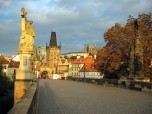The Strahov Monastery is a medieval monastery in the Strahov district of Prague. It was founded by the Bishop of Prague in the 1140’s, in partnership with Duke Vladislav II. The monastery is particularly renowned for its library, which contains more than 200,000 volumes and is lavishly decorated. It was taken over by Czechoslovakia’s communist regime after WWII, but extensively restored after the Velvet Revolution of 1989.
Historical Background
St. Norbert founded the Premonstratensian Order in 1120, and they soon became known as the White Canons. In 1143, they adopted the Strahov Monastery as their home, replacing the unsuccessful order which had been there for the previous three years, since the building’s initial construction. The monastery was well situated, being close to the most commonly used route to Prague Castle.
The Premonstratensians quickly made a success of the monastery. Before the 12th century was out, the place had become not only important spiritually, but also one of the region’s foremost centers of intellectual learning. The majority of the wooden structures which had been used in the initial building had been replaced before 1200, mostly with stone used in the Romanesque style.
Decline and Recovery
A devastating fire hit the complex in 1258, this necessitated a complete rebuilding. This time the structure was built in the then fashionable Gothic style. The monastery continued to be a prosperous place for almost two centuries, but in 1420 Hussites attacked and plundered it of many of its treasures. This proved to be a devastating blow to the order’s fortunes. The monastery was unable to recover and the building fell into a long decline which lasted until around 1600.
Although considerable repair work was carried out in the early 17th century, the Thirty Years War shortly afterward again resulted in heavy damage to the monastery and its contents. Around 1700, Strahov Monastery was restored and expanded with the use of baroque architecture. Rebuilding work continued after it had sustained a heavy bombardment by French troops in 1742. Most of the buildings which now exist at the monastery therefore date from the middle of the 18th century.
Prominent Buildings
Among the oldest extant buildings is the Theological Hall, which dates from the 1670’s. The library, which is richly decorated with a number of frescoes, is contained here and preserves many rare and valuable books. The frescoes themselves, which show scenes relating to librarianship, took four years to paint. Nearby is the Philosophical Hall, which dates from the 1780’s and again contains some remarkable ceiling art. These frescoes, which are by Maulbertsche, depict the course of human history.
The monastery’s church, as it stands today, was substantially rebuilt after the 1742 French attack. However, its history goes back to the basilica of the 12th century, which was ruined by the 1258 fire. More recent repairs contribute to the current church’s appearance. As with the Theological and Philosophical Halls, the nave of the church contains frescoes, including one showing the order’s founder, St. Norbertus. An organ once played by Mozart also stands here.























